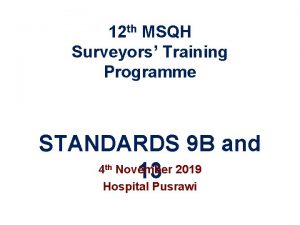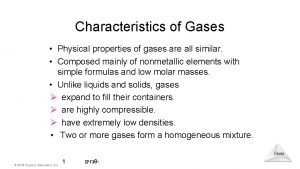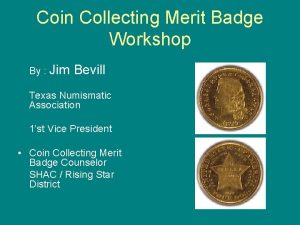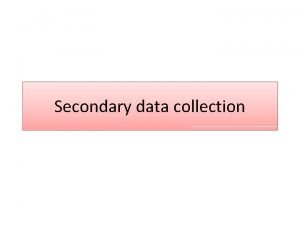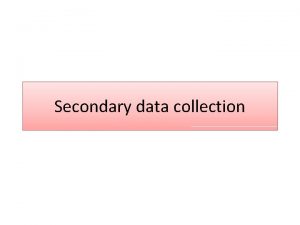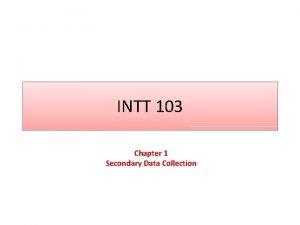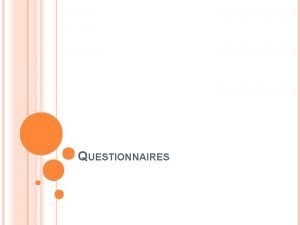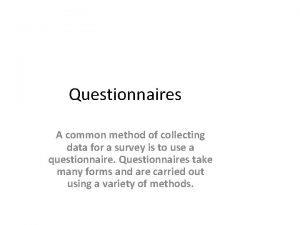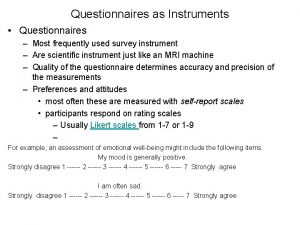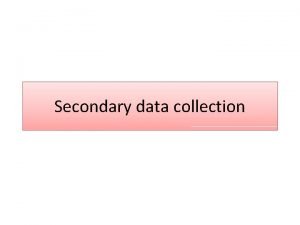Chapter 11 Collecting primary data using questionnaires Introduction

















































- Slides: 49

Chapter 11 Collecting primary data using questionnaires

Introduction l Questionnaire is a general term that includes all techniques of data collection in which each person is asked to respond to the same set of questions in a pre-determined order. It therefore includes both structured interviews and telephone questionnaires as well as those in which the questions are answered without an interviewer being present.

Introduction l As each person (respondent) is asked to respond to the same set of questions, it provides an efficient way of collecting responses from a large sample prior to quantative analyses.

Introduction l l l However, it is harder to produce a good questionnaire than you might think: You need to ensure that it will collect the precise data that you require to answer your research question and achieve your objectives. You will be unable to go to those anonymus individuals and collect additional data using another questionnaire.

Introduction Important steps are: l l Careful design of individual questions Clear layout of the questionnaire form Detailed explanation of the purpose of the questionnaire Carefully planned and executed administration

Questionnaire Techniques l Questionnaires can be used as the only data collection method, but also it is usually better to link them with other methods, such as in-depth interviews.

Types of Questionnaire l The design of a questionnaire differs according to how it is administered and the amount of contact you have with the respondents.

Types of Questionnaires l Self-administered questionnaires are usually completed by the respondents. Such questionnaires are administered electronically using the Internet, posted to respondents who return them by post after completion.

Types of Questionniares l Responses to intervieweradministrated questionnaires are recorded by the interviewer on the basis of each respondent’s answers.


The choice of questionnaire l l l Characteristics of the respondents from whom you wish to collect data Importance of reaching a particular person as respondent Importance of respondents’ answers not being contaminated or distorted

The choice of questionnaire l l l Types of questions you need to ask to collect your data Number of questions you need to ask to collect your data. Size of sample you require for your analysis, taking into account the likely response rate

The choice of questionnaire BE CAREFUL l l l Respondents to self-administrated questionnaires can discuss their answers with others Responses can be distorted when recorded If the respondents have insufficient knowledge or experience, they may deliberately guess at the answer

Data analyze l Some software packages allow you to both design your questionnaire and to enter and analyse the data within the same package; like SNAP and Sphinx. Survey.

Research design requirements l Unlike semi-structured interviews, the questions you ask in questionnaires need to be defined precisely prior to data collection. l Quesitonnaire offers only one chance to collect data

Research design requirements l Before designing your questionnaire, you must review the literature carefully and discuss your ideas with other experts.

Research design requirements l You also need to be clear about which relationships you think are likely to exist between variables: l Dependent variable: It changes in response to changes in other variables l Independent variable: It causes changes in dependent variables

Types of variable l Opinion variables record how respondents feel about something or what they think or believe is true or false l However, when recording what respondents do, you are recording their behaviours, a concrete experience. l Attribute variables contain data about the respondents characteristics; things a respondent possesses, rather than things a respondent does.

Designing individual questions l l You need to consider the type and wording of the questions. Your wording should be clear and understandable to respondents. Most types of questionnaire include a combination of open and closed ended questions.

Open questions l Open-ended questions are used widely in indepth and semi-structured interviews. In questionnaires they are useful if you are unsure of the response. Example: 6. Please list up to three things you like about your job 1. 2. 3. ……………………………

Open questions l With open questions the precise wording of the question and the amount of space partially determine the length and the fullness of the response. However if you leave too much space, the question becomes off-putting. Therefore, it is better to keep their use to minimum.

Close ended questions Divided mainly into six types: l l l List questions Category questions Ranking questions Rating questions Quantity questions

List questions l List questions offer the respondent a list of responses, any of which they can choose. The list of responses must be defined clearly and meaningfully to the respondent. You may also wish to add a catch-all category of ‘other’.

List questions Example: 7. What is your religion? Please tick the appropriate box Buddhist Christian Hindu Jewish Muslim None Other (please say): ………….

Category questions l Category questions are designed so that each respondent’s answer can fit only one category. It is better to limit the categories between five and eight. l You should arrange responses in a logical order so that it is easy to locate the response. Your categories should not overlap, and should cover all possible responses.

Category questions Example 8. How often do you visit this shopping center? First visit Once a week Less than fortnightly to once a month 2 or more times a week Less than once a week to fortnightly Less often

Ranking questions l l A ranking question asks the respondent to place things into rank order. This means that you can discover their relative importance to the respondent. Make sure the instructions are clear and will be understood by the respondent. Your list should be at the most seven or eight items.

Ranking questions Example: 9. Please number each of the factors listed below in order of importance to you in your choice of a new car. Number the most important 1, next 2 and so on. If a factor has no importance at all, please leave blank. Factor Importance Acceleration () Boot size () Depreciation () Safety features () Fuel economy () Price () Driving enhoyment () Other (). . . . . (please describe)

Rating questions l Rating questions are often used to collect opinion data. The respondent is asked how strongly he/she agrees or disagrees with a statement , usually on a four-, five-, six-or seven-point scale. You should include both positive and negative statements so as to ensure that respondents reads each one carefully and think about which box to tick.

Rating questions Example 10. For the following statement please tick the box that matches your view closely. agree I feel that employees’ views have influenced the decisions taken by management tend to agree tend to disagree

Rating questions Example 12. For the following statement please circle the number that matches your view most closely. This concert was. . Good value 10 9 8 7 6 5 4 3 2 1 Poor value for money

Quantity questions l The response to a quantity question is a number, which gives the amount of a characteristic. Such questions tend to be used to collect behaviour or attribute data.

Quantity questions Example: 14. What is your year of birth? 1 9 8 0 (for example, for 1980, write: )

Quantity questions Example: l For each of the following statements please tick the box that most closely matches your experience. . monthly 23. I receive a company site newsletter. . 24. I receive other company publications. . every 3 every 6 months never

Question wording Ask yourself; l l l Can your question be shortened? Are you asking more than one question at a time? Does your question imply that a certain answer is correct? Are there any words in your question that might cause offence? Will all words be understood by all respondents in the same way?

Question coding l If you are planning to analyse your data by computer, they will need to be coded prior to entry. For quantity questions, actual numbers can be used as codes. For other questions you will need to design a coding schema.

Designing the survey form l The order and flow of questions: To assist the flow of the survey, it may be necessary to include filter questions. These identify those respondents for whom the following question/s are not applicable, so they can skip those questions. But be careful about not using more than two or three filter questions as resposndents might be annoyed.

Designing the survey form Example for filter question: 19. Are you currently registered as employed? Yes No If ‘no’ go to question 25

Designing the survey form l The layout of questionnaire: l Interviewer administered questionnaires should be designed to make reading questions and filling in responses easy. The layout of the self-administered questionnaires should be attractive enough to encourage the respondent to fill it in, while not appearing too long. l

Designing the survey form l The layout of questionnaire: l Do not make the questionnaire longer than is really necessary to meet your research question and objectives. Do not be too obsessed with the length of your questionnaire. In general, a length between four and eight A 4 pages is acceptable. l l

Business Research Skills Designing Questionnaires DO’s and DON’Ts

Introduction l l It’s usually best to start a survey with general questions that will be easy for a respondent to answer. It’s usually best to ask any sensitive questions, including demographics (especially income), near the end of the survey.

Designing Questionnaires l Begin with non-threatening, easy to answer questions. How long have you been with BSC Computer Services? _____ yrs l Make your items as brief as possible. l Emphasize the crucial words in each item.

Designing Questionnaires l Group items into coherent categories. How long have you been a supervisor? ____under 2 years ____2 to 8 years ____9 to 15 years ____over 16 years l Leave space for comments, as well as, to make it appear less cluttered

Designing Questionnaires l Provide variety in the type of items used. l a. b. c. l True/False l Rank 1 -4….

Designing Questionnaires l Don’t use negatively worded question if possible Do you feel that working with this company is stressful? ____ yes ____ no

Designing Questionnaires l Don’t use double barreled items This program has increased the capability of performing current or future job tasks. ____ True ____ False

Designing Questionnaires l Don’t include extraneous or unnecessary items. Don’t bias respondents by hinting to a desired response. Don’t use ambiguous, bureaucratic, technical or colloquial language. Do you agree that the management team is fair to all employees? ______ yes ______ no

Designing Questionnaires l Don’t put important items at the end. List below how you feel the issue can be resolved: Don’t ask questions to which you already know the answers. Project Management Training is available to Supervisors? ____ yes ____ no l
 Highly structured questionnaire
Highly structured questionnaire What is responsive speaking
What is responsive speaking Naep survey questionnaires
Naep survey questionnaires Lecture automatique de questionnaires
Lecture automatique de questionnaires Msqh survey questionnaires
Msqh survey questionnaires Interviews and questionnaires
Interviews and questionnaires Questionnaires about vaal river
Questionnaires about vaal river Collecting highly parallel data for paraphrase evaluation
Collecting highly parallel data for paraphrase evaluation Collecting and displaying data
Collecting and displaying data Samples of collecting engineering data
Samples of collecting engineering data Chapter 34 collecting and testing specimens
Chapter 34 collecting and testing specimens Regulation of tubular reabsorption
Regulation of tubular reabsorption Ductnn
Ductnn Internal naris
Internal naris Key takeaways examples
Key takeaways examples Coupon collecting problem
Coupon collecting problem Collecting gas over water
Collecting gas over water Lymphatic trunk
Lymphatic trunk Collecting gas over water
Collecting gas over water Physics or stamp collecting
Physics or stamp collecting Boy scout coin collecting merit badge
Boy scout coin collecting merit badge Collecting gas over water
Collecting gas over water Algebra dr frost
Algebra dr frost Prize collecting steiner tree
Prize collecting steiner tree Who is a collecting banker
Who is a collecting banker Collecting information and forecasting demand
Collecting information and forecasting demand Make tag questions for the following sentences
Make tag questions for the following sentences Renal papilla
Renal papilla Collecting ducts
Collecting ducts Collecting duct meaning
Collecting duct meaning Selective reabsorption in the proximal convoluted tubule
Selective reabsorption in the proximal convoluted tubule Collecting ducts
Collecting ducts Peritubular capillaries vs vasa recta
Peritubular capillaries vs vasa recta Nitrogenous waste
Nitrogenous waste Collecting duct meaning
Collecting duct meaning Collecting information and forecasting demand summary
Collecting information and forecasting demand summary Research questions
Research questions Secondary data
Secondary data What is primary data
What is primary data Primary data is
Primary data is Primary data and secondary data
Primary data and secondary data Example of interval level of measurement
Example of interval level of measurement Introduction to data warehouse
Introduction to data warehouse The primary pigment colors are ____.
The primary pigment colors are ____. Is biography a primary source
Is biography a primary source Are autobiographies primary sources
Are autobiographies primary sources Using system.collections
Using system.collections Dtfd switch
Dtfd switch The cars model
The cars model Newff matlab
Newff matlab




